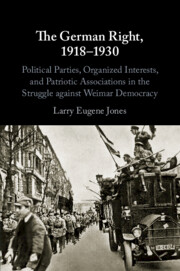 The German Right, 1918–1930
The German Right, 1918–1930 Published online by Cambridge University Press: 21 March 2020
Chapter 3 focuses on the history of the DNVP from the elections to the Weimar National Assembly to the Reichstag elections of June 1920. It deals in particular with the way in which the DNVP established itself as a party of “national opposition” at the National Assembly with particular attention to its positions on the Weimar Constitution and the Versailles Peace Treaty. It also examines the success with which hard-line conservatives around Count Westarp were able to assert themselves in the deliberations over the party program and in pushing back against efforts of the young conservatives around Ulrich von Hassell to shape the DNVP into a progressive conservative party free from the follies of the past. The chapter ends with the Kapp putsch in March 1920, the adoption of the party program a month later, and the Reichstag elections of June 1920 in which the DNVP improves upon its performance at the polls in the elections to the National Assembly.
To save this book to your Kindle, first ensure [email protected] is added to your Approved Personal Document E-mail List under your Personal Document Settings on the Manage Your Content and Devices page of your Amazon account. Then enter the ‘name’ part of your Kindle email address below. Find out more about saving to your Kindle.
Note you can select to save to either the @free.kindle.com or @kindle.com variations. ‘@free.kindle.com’ emails are free but can only be saved to your device when it is connected to wi-fi. ‘@kindle.com’ emails can be delivered even when you are not connected to wi-fi, but note that service fees apply.
Find out more about the Kindle Personal Document Service.
To save content items to your account, please confirm that you agree to abide by our usage policies. If this is the first time you use this feature, you will be asked to authorise Cambridge Core to connect with your account. Find out more about saving content to Dropbox.
To save content items to your account, please confirm that you agree to abide by our usage policies. If this is the first time you use this feature, you will be asked to authorise Cambridge Core to connect with your account. Find out more about saving content to Google Drive.